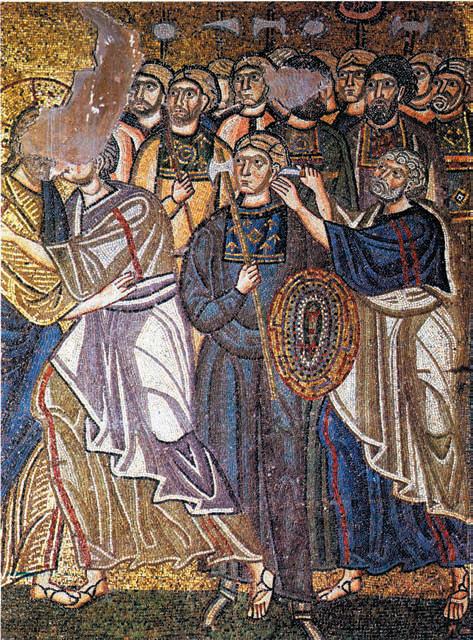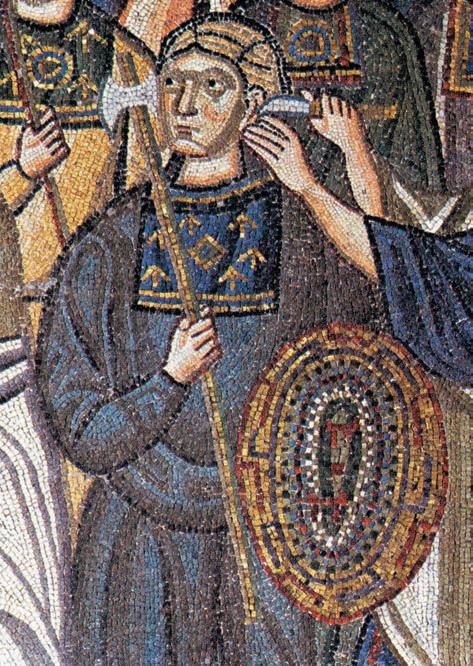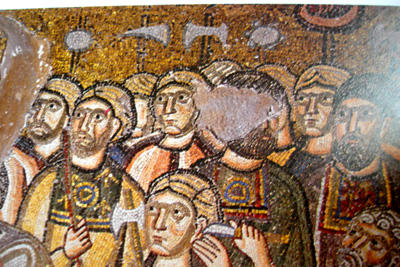Amazon Prime Student 6-month Trial

Amazon Audible Gift Memberships
The Betrayal, Nea Moni, Chios, mosaic of the inner Narthex, 1043 AD.

Fig. 1. The Betrayal, Nea Moni, Chios, mosaic of the inner Narthex, 1043 AD, ex Mouriki

Fig. 2. The Betrayal, Nea Moni, Chios, detail of Malchus, 1043 AD, author’s collection

Soldiers
The 11th c: Imperial Guardsmen in the Nea Moni monastery, c. 1043 AD, and parallels
The scene of the Betrayal in the famous Imperial Monastery of the Virgin of Nea Moni in Chios is represented in the inner narthex.8
It shows Roman warriors dressed in a very elaborated way, of blonde complexion and very strong physical constitution (Fig. 1).
They are armed with staff weapons, in detail with double and single-edged axes, curved blades and maces.
One of them carries a very precious shield, decorated with pearls, and the axe is carried on the right shoulder.
Some of the shafts of their weapons are brightly painted in different colours.
8 Mouriki 1985, pp. 86-87, 184-186, Pls. 102, 106, 107, 268, 272-273.
The men are not represented as clad in armour, but this does not exclude their military character.
The luxury of their equipment suggests to me that the unknown artist seems to have used Imperial Guardsmen as models for the Roman soldiers arresting Christ.
Their weaponry is partially respecting the Biblical text, because they also have staves and lamps,
but their armament is heavy and more typical of professional soldiers, as is their costume.
Did indeed the unknown mosaic-maker use Imperial Guardsmen as models for the speira described by the Evangelists?
The Nea Moni Monastery was an Imperial foundation, and the date of the mosaic coincides with the rule of Constantine IX Monomachos (1042–1055).9
The famous Varangian Guard of the Emperors of Byzantium, loyal to the Macedonian Dynasty, was formed by Rus and Scandinavians, often with blonde hair and long beards10
exactly as the warriors on the mosaic.
They were dressed at the court in the elaborate Skaramangia (long robes) of the Imperial Guards,
mentioned in the Book of Ceremony (De Cer. II, 578) or the Allaximata (uniforms)11 of their own unit (De Cer. I, 225), with decorated Pektoraris.
The warriors of the mosaic are indeed all dressed in skaramangia of different colours (blue, yellow, orange, violet, green) lavishly ornamented by an overdressed Pektoraris.
These were silk or embroidered squared decorations applied over the main dress.12
Shaped like small mantles, they came down from the neck, behind which they were fastened, descending over the breast and sometimes over the entire body.13
One of the few representations of this guardsman’s dress is exactly that of the Nea Moni mosaic (Fig. 2) where, on the person identified as “Malchus”14
– the servant of the High Priest whose ear was cut off by Saint Peter – the artist detailed even the black laces coming down from the neck and fastening the garment behind it.
So there is no doubt that the men represented on the mosaic were mirrored from real Imperial Guardsmen, whose core in that period was formed by the Varangian Guard.
The historian Psellos (VI, 87; VII, 24) describes the Varangians as bearing axes or pelekys on the right shoulder (VI, 3).
The great Danish axe was the main weapon of the Varangians,15 together with other smaller kinds of such weapons.
Another important weapon of the Imperial Guardsmen was the Rhomphaia, a two-handed curved sword, shaped like a medium long pole-arm with a long,
narrow blade hooked at the point, or a long pole-arm with a scythed spear-like blade, of about the same length as its hilt.16
Both these weapons are well illustrated in the mosaic.
The weapon of Malchus, moreover, presents a shaft painted with one row of brown, one row of gold and one row of green colour (Fig. 2).
The habit of painting the shafts of the imperial Guardsmen’s spears and pole-weapons in three different bands of colours is well attested in the 6th c.
in the famous mosaic of Justinian and his retinue kept in the Church of San Vitale in Ravenna.17
Also this detail of the Nea Moni mosaic may have been therefore copied from reality, attesting a military attire still in vogue after centuries.
9 Mouriki 1985, pp. 21ff.
10 D'Amato 2010, pp. 22, 43-44, 46.
11 Among the αλλαξιμα there were the σκαραμανγια, the στεμματα, the λωροι, the precious χλαμυδα and the διβητισια; see Kukulès,1953, II,2,21.
12 De Cer., I, 391.
13 Reiske 1830, I, p. 378; Du Cange, 1688, s.v. Pectoralis, Pectorale, col. 237c, 238a.
14 Mouriki 1985, p. 87.
15 D'Amato 2010, pp. 35-36.
16 D'Amato 2010, pp. 37-39.
17 Grabar 1966, pp. 159-160, fig. 171; Southern, Dixon 1996, p. 102 fig. 22; the decorated shafts of the Guardsmen are for half of their diameter gilded for their full length, the other side appears to be alternate 2 inch sections in blue and green, separated by narrow half bands of silver, see also Barker 1981, p. 82 fig. 58.
The Malchus' shield is a precious round aspis decorated on its surface with what seems to be precious stones and pearls. Shields decorated with pearls are attested by the sources and other iconography of the period as used by the Imperial Guard. In the Oratory of Saint Theodore, in the Khrisotriklinios, were preserved the Imperial shields that were exhibited, together with the Imperial spears, by the accompanying Guardsmen. One of the shields was a gold Skouton enamelled with pearls, the other was a shield similarly decorated with gems and precious stones (De Cer. 640, 12ff.):
σκουτον χρυσουν χειμευτον ημφιεσμενον απο μαργα-ρων. ετερον σκουτον χρυσουν χειμευτον ημφιεσμε-νον απο λιθων και μαργαρων (golden shield decorated with pearls. A second golden shield decorated by precious stones and pearls)18.
18 Kolias 1988, p. 26 and n. 200 remembers the high difference between the shields of the Imperial guardsmen and those of common soldiers. See also Theoph. Cont., 407, 7ff.,12, on the gold and silver shields of the Guardsmen of Simeon (χρυσασπιδων-αργυρασπιδων);
Source: pp.70-73, Raffaele d'Amato The Betrayal: Military Iconography and Archaeology In The Byzantine Paintings Of The 11th-15th C. AD Representing The Arrest Of Our Lord
See also Byzantine Mosaic depicting the soldier, Longinus, in the Nea Moni Church, Chios, Greece, c.1049-55AD
Varangian Guard(?) in The Betrayal, Balleq Kilise, Cappadocia, Byzantine, 11th Century.
Other Byzantine Illustrations of Costume & Soldiers
11th Century Illustrations of Costume & Soldiers



